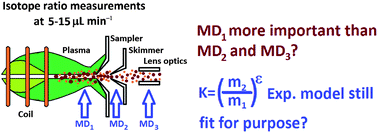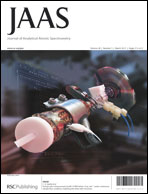The need for performing isotope ratio measurements by MC-ICPMS on samples only available in small sizes and not allowing any dilution requires the development of sample introduction systems that can run below 10 μL min−1 sample flow rate (continuous mode). With a torch integrated sample introduction system (TISIS), optimisation of the running conditions involves the study of the temperature of the spray chamber (TSC). This paper investigates the consequences of changing TSC up to 100 °C and the sample flow rate down to 5 μL min−1 on mass discrimination effects. The validity of the exponential model commonly used to correct for these effects was tested for strontium isotopic measurements. Two categories of processes favouring the heaviest isotopes were envisaged: at plasma stage – “mechanism 1”, and within the ion beam – “mechanism 2”. The extraction potential applied inside the interface (HV1) was progressively increased, and results obtained for a range of approximately ±5 to 6 V around HV1 = 4004 V at 15 μL min−1 and TSC = 40 °C were used as reference. The intensity of mass discrimination effects increased at 15 μL min−1 and TSC = 60 or 100 °C, and decreased at 5 μL min−1 and TSC = 40 °C. At TSC = 100 °C (15 μL min−1) or at 5 μL min−1 (TSC = 40 °C) the stability of mass discrimination effects and the average efficiency of the exponential model were particularly degraded. The contribution of mechanism 1 (and its influence on mechanism 2) seemed to be the determining factor. At TSC = 100 °C the hypothesis made was the acceleration of the solvent evaporation process inside the TISIS, leading to variations in the characteristics of the tertiary aerosols. And the consequence was an increase of the plasma mass discriminative effects (ion diffusion) reinforced by the extra energy made available to the plasma ions. At 5 μL min−1, changes in the plasma composition arising from the reduction of the water load in combination with the ion production at an earlier stage within the plasma followed by the processes of ion diffusion were also hypothesized as possible causes for the inadequacy of the exponential model.

You have access to this article
 Please wait while we load your content...
Something went wrong. Try again?
Please wait while we load your content...
Something went wrong. Try again?


 Please wait while we load your content...
Please wait while we load your content...